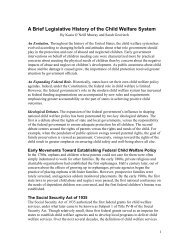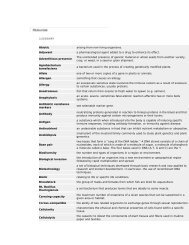Protecting Western Australia's Big Blue Backyard - The Pew ...
Protecting Western Australia's Big Blue Backyard - The Pew ...
Protecting Western Australia's Big Blue Backyard - The Pew ...
You also want an ePaper? Increase the reach of your titles
YUMPU automatically turns print PDFs into web optimized ePapers that Google loves.
In supporting an end<br />
to whaling, <strong>Western</strong><br />
Australians made a major<br />
contribution to the cause<br />
of protecting the world’s<br />
marine life taking refuge<br />
in their waters<br />
COOLER AND STORMIER WATERS WITH<br />
GRANITE REEFS<br />
<strong>The</strong> turbulent mixing of water at Cape Leeuwin<br />
saps the Leeuwin Current of some of its energy<br />
as it turns to head east along the south coast.<br />
From here it leaves behind the limestone coast<br />
and flows into the stormier waters of the south<br />
coast and a very different marine environment.<br />
Along the region’s south coast there is little<br />
protection from fierce southerly swells and inshore<br />
lagoons are absent. <strong>The</strong> Leeuwin Current is also<br />
in competition with the cooler Flinders Current<br />
from the east carrying the larvae and fish eggs<br />
of cool-water species.<br />
<strong>The</strong> south coast’s cliffs and reefs are carved from<br />
hard granite, a rock that erodes very slowly,<br />
even on coastlines like this where the energy of<br />
the waves can be felt at a depth of 100 metres.<br />
With little erosion, the reefs here have far fewer<br />
microhabitats than the west coast’s myriad<br />
of caves and crevices etched in soft limestone.<br />
As a result, there are lower numbers of bottomdwelling<br />
species such as crabs and rock lobsters.<br />
Kelp beds and sponge communities cover the<br />
south coast’s reefs which are generally in deeper<br />
water than those of the west coast. <strong>The</strong> clear<br />
waters allow light to penetrate deeply and kelp<br />
to grow at depths of up to 120 metres.<br />
Leafy and weedy seadragons gently hover among<br />
the swaying kelp blades. <strong>The</strong>se beautiful and<br />
fragile creatures are only found in Australia’s<br />
southern waters and are threatened by harvesting<br />
for the aquarium trade and as accidental catch in<br />
fishing nets.<br />
In these cooler south-coast waters the composition<br />
of marine species changes. <strong>Western</strong> rock lobster<br />
are replaced by the southern rock lobster, and the<br />
West Australian dhufish and baldchin groper give<br />
way to mulloway, harlequin cod and bight redfish.<br />
Greenlip abalone, not found on the west coast,<br />
occurs here in relatively large numbers.<br />
Compared with the limestone coast of the west,<br />
there is a greater proportion of bottom-dwelling<br />
finfish relative to crustaceans. Surface-dwelling<br />
fish numbers are higher on the south coast’s<br />
continental slope.<br />
<strong>The</strong> creation of large no-take marine reserves can<br />
ensure the protection of the various habitats found<br />
along the west and south coasts, in offshore and<br />
nearshore waters and on the sea floor.<br />
CANYON COUNTRY, WHALES AND<br />
ORANGE ROUGHY<br />
Near Albany the Leeuwin Current encounters<br />
what the locals call the Albany Hills, even though<br />
there is nothing small about the Albany Canyons.<br />
Here 32 canyons spread along 700 kilometres of<br />
the continental slope from Albany to the east of<br />
Esperance. Offshore eddies and upwellings spur<br />
plankton production and feeding frenzies by small<br />
and large surface-dwelling fish.<br />
Deep sea orange roughy gather in the Albany<br />
Canyons to spawn, possibly along with blue<br />
grenadier and gemfish. Until 2005, commercial<br />
fishers were allowed to target the orange roughy,<br />
but by 2007 only bycatch was permitted, set at five<br />
per cent of previous allowable catches. Here and<br />
throughout Australia the stocks of orange roughy<br />
have been overfished and their deep sea habitats<br />
severely damaged by bottom trawling. <strong>The</strong> species<br />
is now listed as ‘of conservation concern’ under<br />
federal environmental law.<br />
Every summer the southern right whales of<br />
<strong>Western</strong> Australia go to the sub-Antarctic to<br />
feed. In winter they return to calve in the Leeuwin<br />
Current’s warm waters between the Albany<br />
Canyons and the coast. <strong>The</strong> sheltered Princess<br />
Royal Harbour at Albany is a favoured location for<br />
these rare whales, much to the delight of whale<br />
watchers and whale tour operators.<br />
Only a few hundred southern right whales live<br />
along the Australian coast. <strong>The</strong>y are still recovering<br />
from the days of commercial whaling when 26,000<br />
were killed in Australian and New Zealand waters<br />
before whaling was banned.<br />
Sperm whales are also known from the canyons<br />
of this area where they might swoop down the<br />
slope in pursuit of a giant squid. In 1978 two giant<br />
squid were found in the stomach of a sperm whale<br />
caught in the final days of the Cheynes Beach<br />
Whaling Company station at Albany. Sperm whales<br />
had become the target of the station after whaling<br />
for humpbacks was banned in 1963.<br />
On 20 November 1978, the company caught<br />
a sperm whale that was to be the last whale to<br />
be killed in Australian waters. <strong>The</strong> next day the<br />
station, the last in Australia, closed. In April of<br />
1979 the Australian Government banned<br />
commercial whaling in Australian waters.<br />
In supporting an end to whaling, <strong>Western</strong><br />
Australians made a major contribution to the<br />
cause of protecting the world’s marine life taking<br />
refuge in their waters. Since then Australia has<br />
become a global champion for whales. And the<br />
ban on whaling is now reaping huge rewards back<br />
home with the rapidly growing whale-watching<br />
industry fuelling jobs and tourism in <strong>Western</strong><br />
Australia and beyond. <strong>Protecting</strong> marine life can<br />
provide long-term economic benefits and is further<br />
reason to establish a CAR network of large no-take<br />
marine reserves in the Kalbarri to Eucla region.<br />
Deep-diving sperm whales were<br />
harvested in Australian waters<br />
until 1978 when the Albany<br />
whaling station – the last in<br />
Australia – was closed<br />
© marinethemes.com / Tony Wu<br />
51
















